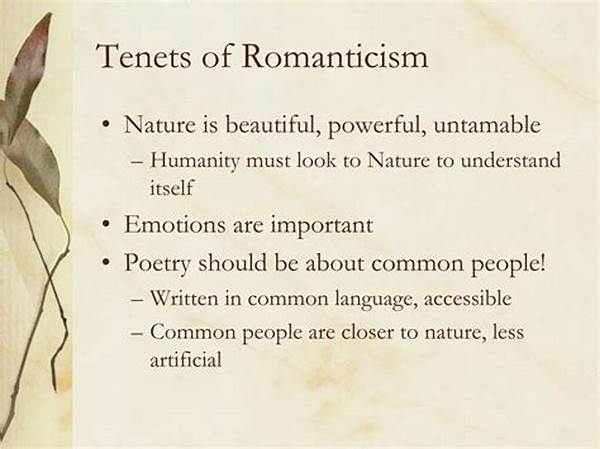The exploration of romantic narratives across cultures delves into the intricate tapestry of human emotion and storytelling that transcends geographical and linguistic boundaries. Throughout history, humans have yearned to understand and express the complexities of love, infusing their tales with sociocultural elements unique to their lived experiences. Across various societies, romantic narratives serve as a mirror reflecting societal values, beliefs, and norms surrounding love and relationships. These stories capture the essence of human connections, presenting both shared themes and distinct interpretations that enrich our understanding of what it means to love.
Read Now : Popular Manor Houses In Romances
Diversity in Romantic Narratives
In examining romantic narratives across cultures, one cannot overlook the diversity that characterizes these stories. Each culture offers a unique perspective, illustrating how love is perceived and experienced differently. While some cultures emphasize the melodrama and tragedy inherent in romantic tales, others present love as a journey filled with humor and joyous discovery. For instance, classic Western romances often explore themes of individualism and passion, while Eastern narratives might highlight duty, honor, and societal obligations. In Africa, storytelling traditions frequently incorporate elements of community, ancestors, and spiritual connections in romantic narratives. This confluence of varying perspectives broadens our understanding, offering a rich tapestry of universal and contrasting elements in the depiction of love.
Common Themes in Romantic Narratives
1. Love Conquers All: This universal theme in romantic narratives across cultures suggests that true love can overcome any obstacle or adversity.
2. Forbidden Love: Many cultures have tales of lovers defying societal norms or familial expectations, accentuating the tension between love and duty.
3. Unrequited Love: Stories across various societies detail the emotional turmoil and growth stemming from unreciprocated affection.
4. Eternal Love: Myths and legends often explore the concept of love that transcends time and mortality.
5. Love and Sacrifice: Romantic narratives across cultures frequently emphasize the notion that love requires profound personal sacrifice for the beloved’s happiness.
Historical Perspectives on Love Stories
Throughout history, romantic narratives across cultures have evolved, reflecting changes in societal norms, religious beliefs, and historical contexts. In ancient times, many cultures revered divine or mythical love stories, integrating elements of the supernatural and divine intervention. As societies advanced, the humanization of romantic narratives became prevalent, focusing on earthly relationships and realistic settings. Literature and oral traditions serve as vessels for these stories, capturing the evolution from divine myths to contemporary tales of modern romance. Such narratives offer insights into how different eras and cultures grapple with the enduring mystery of love, providing a window into historical and cultural transformations that continue to shape romantic expressions today.
Read Now : Recommended Historical Romance K-dramas
Analyzing Cross-Cultural Romantic Themes
To critically examine romantic narratives across cultures, one should consider the interplay between tradition and innovation in storytelling. Traditional tales often contain timeless motifs and archetypes that transcend cultural boundaries, such as the archetypal journey of lovers facing adversity. Conversely, modern narratives may introduce progressive themes that challenge conventional perspectives, such as non-binary representations and diverse family structures. This dynamic interaction results in a vibrant literary landscape, where ancient motifs coexist with modern innovations, offering readers a nuanced understanding of love’s portrayal across continents and epochs.
Symbolism in Romantic Literature
Symbolism plays a pivotal role in romantic narratives across cultures, offering deeper layers of meaning beyond explicit storytelling. These symbolic elements often reflect a culture’s unique ethos, bridging emotional experiences with abstract concepts. For example, flowers frequently symbolize love and beauty in many cultures, yet specific blooms may hold particular significance. The red rose in Western culture epitomizes passionate love, while the lotus in Eastern narratives might symbolize purity and spiritual awakening. Similarly, the moon is a recurring symbol, often signifying mystery, change, and romance. Such symbols transcend cultural differences, providing a universal language through which audiences can connect with the essence of romantic stories.
Evolution of Romantic Archetypes
The evolution of archetypes within romantic narratives across cultures illustrates a fascinating interplay between cultural continuity and change. Throughout history, recurring figures such as the tragic hero, the star-crossed lovers, and the wise elder have resonated with audiences worldwide. These archetypes embody universal human experiences, capturing the beauty and anguish of love. As societal norms shift, the portrayal of these figures adapts, reflecting contemporary attitudes and values. For instance, modern narratives may reframe traditional archetypes to include diverse identities, gender roles, and relationship dynamics, offering fresh perspectives that align with contemporary ideals of inclusion and equality.
Conclusion: The Enduring Power of Love Stories
In conclusion, the study of romantic narratives across cultures provides a profound understanding of how societies articulate and interpret the complexities of love. These stories serve as cultural barometers, reflecting and shaping collective views on relationships, emotions, and societal norms. Through their exploration, one gains insight into both shared human experiences and the exquisite diversity that characterizes global expressions of love. Ultimately, whether told in ancient myths or modern novels, romantic narratives possess an enduring power to connect people across cultures, celebrating the universal language of love that binds humanity together.
